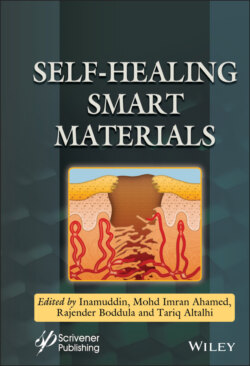Читать книгу Self-Healing Smart Materials - Группа авторов - Страница 28
3.1 Introduction
ОглавлениеElastomers are elastic polymers that are highly flexible. They are used in a huge number of applications, such as tires, seals, biomaterials, soft robotics, wearable electronic devices and sensors. Elastomer compounds present excellent mechanical properties due to the formation of a stable three dimensional network of covalent bonds in the vulcanization process, but make the material not or almost not self-healable due to the irreversibility of the covalent bonds. Actually, the rubber industry looks for new challenges to contribute to sustainable development. Consequently, it is necessary to develop sustainable materials and methods in order to extend the life cycle of vulcanized elastomers [1]. An alternative to reach this goal is the concept of self-healable elastomeric compounds.
Self-healable materials can be defined as a smart material that responds to stimulus to extend its service life by restoring mechanical integrity after damage. The capacity for self-healing is usually observed in animals and plants. Any industrial component with this capacity would be beneficiated in the presence of defects in service, such as micro cracks [2, 3]. The goal of developing self-healable materials is to extend the long-term durability by effectively removing any local damage that occurs during its service life [4–8]. Another advantage of self-healable rubber is that can prevent catastrophic failure [9].
Self-healable materials can be classified as autonomous (do not need a stimulus to conduct the self-healing process), or non-autonomous, in which a stimulus is required to trigger the self-healing mechanism. Some of the most common stimuli are light, mechanical, chemical or heat (Figure 3.1).
Other possible classifications of self-healing materials are as extrinsic and intrinsic types, according to the healing mechanism [10, 11]. The first one is characterized by the storage of the healing agents in nanotubes, microcapsules, or other micro-containers, which can be released after the matrix suffers damage [12, 13]. Intrinsic type refers to those polymers containing covalent or non-covalent either reversible bonds, which activate by external stimulation after damage. Dynamic covalent bonds can be disulfide bonding [14] and reversible Diels–Alder reaction (DA) [15], whereas dynamic non-covalent bonds can be metal–ligand coordination [16, 17], hydrogen bonds [18, 19], hydrophobic and π–π interactions [20–22]. When the self-healing mechanism is due to dynamic bonds, the mechanical strengths are weaker than those systems with permanent covalent bonds. To overcome this drawback, some authors proposed the incorporation of crystalline domains within the polymer matrix to increase the toughness of the system [23–26].
Figure 3.1 Classification scheme of self-healing systems.
Covalent bonds are also capable to self-cure partially when the compound is formulated in a way to obtain high content of di- and polysulfides bridges and a low crosslinks density that permits the rearrangement of the bonds that had been broken at the healed interface. Sometimes, this kind of healing mechanism is preferred over hydrogen bonds, because the last one breaks easily when a mechanical effort is applied [2].
When thermal activation for self-healing is used, systems based on DA reaction are the most common. This reaction consists in a [4 + 2] cycloaddition between an electron poor dienophile and an electron rich diene, producing a cyclohexene adduct which could be reverted via retro-DA reaction (rDA) using high temperature conditions (see Figure 3.2). This reaction presents fast kinetics and soft reaction conditions [27].
Amide is another important bond type for self-healing applications, but it requires extreme conditions to be reversed. A reversion method includes the use of bulky substituents that promotes the breakage of the amine bond.
Wool et al. [28] analyzed the mechanism of intrinsic self-healing polymers and summarized that the process takes five phases: (i) surface rearrangement, (ii) surface approach, (iii) wetting, (iv) diffusion and (v) randomization during which the longitudinal chain diffusion is responsible for crack healing.
